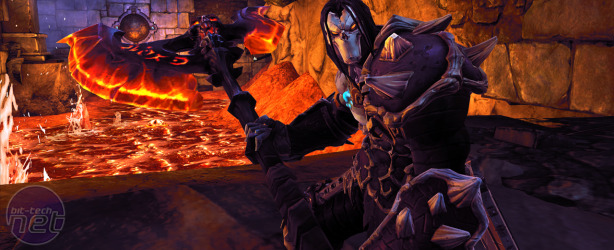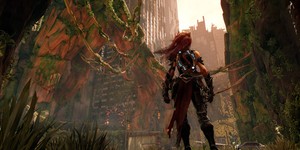
Dungeons are large and plentiful and for the most part a pleasure to explore. The setup is the same as before, which is to say, ripped off from Zelda. Death arrives at a new dungeon explores a bit, finds a map, solves some puzzles, gets an item or ability that unlocks previously inaccessible areas and then defeats a boss or two. But rather than just sticking with, ‘if it ain’t broke, don’t fix it,’ Vigil Games have added, ‘make it bigger’ to the old saying, and while the wider game world benefits from the increased scale some of the dungeons feel overly drawn out.
Ingenious puzzles are introduced and then re-used so much they often become a case of going through the motions. However, working them out for the first time is generally rewarding, making you feel clever for finding the solution without ever being too obtuse. Old favourites such as pressure pads, portals and timed switches make an appearance alongside new additions like the ability to split Death into two spirit versions of himself.

The main reason some dungeons could do with having a bit of fat trimmed is the amount of time they force you to stay in one place. Exploring the vast Forge Lands and beyond is a pleasure. Lush meadows, menacing stonework, spectacular vistas and stormy skylines all create a vibrant and fully realised world that looks amazing. The textures aren’t super high resolution and the framerate sometimes stutters, but these small issues are easily overlooked. The colour palette is varied and each area has a distinct feel thanks to some beautiful design that makes discovering new areas an absolute joy.
Though large, a lot of the potential stresses of a big game world are eliminated by a neat fast travel system. You can instantly hop to key locations, even leaving dungeons to stock up on supplies before returning to the exact spot you left from. Side-quests can be accepted too and as you undertake more tasks a colour-coded quest log keeps things nicely ordered. Of course, you could just not use fast-travel and of course all games are just a series of tasks en route to the end goal, but these systems, though handy, somehow make the game world lack a true sense of place. And though beautiful, the setting feels disjointed compared to the world of Hyrule, for example.
This is compounded by the story, which does very little to disguise the fact it’s just an elaborate collection of fetch quests. The amount of times you are asked to get three items before someone helps you, only to be told you must then collect three more, borders on ridiculous and destroys any sense of real narrative. Like most titles, the story exists purely to create the tasks that make up the gameplay, but with Darksiders II it feels more thinly veiled than usual.

Despite these flaws, Darksiders II is an accomplished game that comes highly recommended. Combat is impressive and a large improvement on the first game, the art design is stunning and the orchestral score compliments the action brilliantly, but most importantly, it's a lot of fun to play. It's also crammed with content - a first playthrough will easily take over 20 hours and that's not including side-quests, which often take place in entirely new locations. It doesn't quite escape the shadows and reach the heights of the giants it looks up to, but with two more horsemen waiting in the wings the Darksiders franchise still has time to grow.
Ingenious puzzles are introduced and then re-used so much they often become a case of going through the motions. However, working them out for the first time is generally rewarding, making you feel clever for finding the solution without ever being too obtuse. Old favourites such as pressure pads, portals and timed switches make an appearance alongside new additions like the ability to split Death into two spirit versions of himself.

The main reason some dungeons could do with having a bit of fat trimmed is the amount of time they force you to stay in one place. Exploring the vast Forge Lands and beyond is a pleasure. Lush meadows, menacing stonework, spectacular vistas and stormy skylines all create a vibrant and fully realised world that looks amazing. The textures aren’t super high resolution and the framerate sometimes stutters, but these small issues are easily overlooked. The colour palette is varied and each area has a distinct feel thanks to some beautiful design that makes discovering new areas an absolute joy.
Though large, a lot of the potential stresses of a big game world are eliminated by a neat fast travel system. You can instantly hop to key locations, even leaving dungeons to stock up on supplies before returning to the exact spot you left from. Side-quests can be accepted too and as you undertake more tasks a colour-coded quest log keeps things nicely ordered. Of course, you could just not use fast-travel and of course all games are just a series of tasks en route to the end goal, but these systems, though handy, somehow make the game world lack a true sense of place. And though beautiful, the setting feels disjointed compared to the world of Hyrule, for example.
This is compounded by the story, which does very little to disguise the fact it’s just an elaborate collection of fetch quests. The amount of times you are asked to get three items before someone helps you, only to be told you must then collect three more, borders on ridiculous and destroys any sense of real narrative. Like most titles, the story exists purely to create the tasks that make up the gameplay, but with Darksiders II it feels more thinly veiled than usual.

Despite these flaws, Darksiders II is an accomplished game that comes highly recommended. Combat is impressive and a large improvement on the first game, the art design is stunning and the orchestral score compliments the action brilliantly, but most importantly, it's a lot of fun to play. It's also crammed with content - a first playthrough will easily take over 20 hours and that's not including side-quests, which often take place in entirely new locations. It doesn't quite escape the shadows and reach the heights of the giants it looks up to, but with two more horsemen waiting in the wings the Darksiders franchise still has time to grow.
-
Overall75 / 100


MSI MPG Velox 100R Chassis Review
October 14 2021 | 15:04









Want to comment? Please log in.